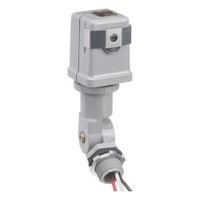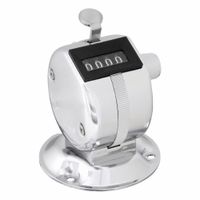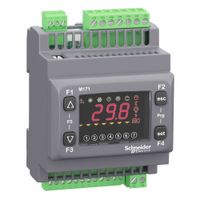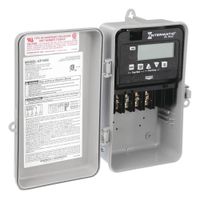Call +(254) 703 030 000 / 751 483 999 / 721 704 777
- Home
- Electrical
- Industrial Controls Automation And Machine Safety
- Industrial Automation
.....Read More
Frequently Asked Questions
What are the benefits of using industrial automation devices for energy savings?
Industrial automation devices offer significant energy savings through enhanced efficiency, precision, and control. By automating processes, these devices reduce human error and ensure optimal operation, minimizing energy waste. They enable real-time monitoring and adjustments, allowing systems to operate at peak efficiency and adapt to changing conditions swiftly.
Automation devices can optimize energy consumption by regulating machinery operation, ensuring that equipment runs only when necessary and at the most efficient levels. This reduces idle times and unnecessary energy use. Advanced sensors and control systems can detect inefficiencies and implement corrective measures instantly, further conserving energy.
Predictive maintenance, facilitated by automation, prevents equipment failures and extends machinery life, reducing the energy-intensive processes of repairs and replacements. Automation systems can also integrate renewable energy sources more effectively, balancing loads and optimizing energy use from these sources.
Moreover, automation enhances data collection and analysis, providing insights into energy usage patterns. This data-driven approach allows for informed decision-making and strategic planning to further reduce energy consumption. Automation can also facilitate demand response strategies, adjusting energy use in response to grid demands, which can lead to cost savings and reduced energy consumption during peak periods.
Overall, industrial automation devices contribute to significant energy savings by improving operational efficiency, reducing waste, and enabling smarter energy management.
How do lighting photocells work to control outdoor devices?
Lighting photocells, also known as photoelectric sensors, control outdoor devices by detecting ambient light levels and switching electrical circuits on or off accordingly. These devices typically consist of a light-sensitive component, such as a photodiode or a phototransistor, which changes its electrical resistance based on the amount of light it receives.
During daylight, the photocell detects sufficient ambient light, causing it to maintain a high resistance state. This high resistance prevents electrical current from flowing through the circuit, keeping connected devices, like outdoor lights, turned off. As daylight diminishes and ambient light levels drop below a predetermined threshold, the photocell's resistance decreases. This change allows electrical current to flow, activating the circuit and turning on the connected devices.
Photocells are often integrated with a relay or a switch that physically opens or closes the circuit based on the photocell's resistance. This mechanism ensures that outdoor devices operate only when necessary, conserving energy and extending the lifespan of the devices.
Some advanced photocells include features like adjustable sensitivity, allowing users to set specific light level thresholds for activation. Additionally, time delay functions can prevent the photocell from reacting to brief changes in light, such as those caused by passing clouds or headlights, ensuring stable operation.
Overall, lighting photocells provide an efficient, automated solution for controlling outdoor devices, enhancing convenience and energy efficiency by responding to natural light conditions.
What role do meters and counters play in industrial automation?
Meters and counters are crucial components in industrial automation, serving as tools for measurement, monitoring, and control. Meters, such as flow meters, pressure meters, and temperature meters, provide real-time data on various process parameters. This data is essential for maintaining optimal operating conditions, ensuring product quality, and enhancing process efficiency. By continuously monitoring these parameters, meters help in detecting anomalies, enabling preventive maintenance, and reducing downtime.
Counters, on the other hand, are used to track discrete events or quantities, such as the number of items produced, machine cycles, or operational hours. They play a vital role in production management by providing data for inventory control, production planning, and performance analysis. Counters can be integrated with other systems to automate processes, such as stopping a machine after a set number of cycles or triggering maintenance alerts.
Both meters and counters contribute to data acquisition systems, feeding information into programmable logic controllers (PLCs) and supervisory control and data acquisition (SCADA) systems. This integration allows for automated decision-making, process optimization, and enhanced control over industrial operations. By providing accurate and timely data, meters and counters enable industries to achieve higher efficiency, reduce waste, and improve safety standards.
How do PLCs and HMIs improve process control and user interaction?
PLCs (Programmable Logic Controllers) and HMIs (Human-Machine Interfaces) significantly enhance process control and user interaction in industrial settings.
PLCs are robust, industrial-grade computers designed to automate control processes. They improve process control by offering precise, reliable, and flexible management of machinery and production lines. PLCs can execute complex algorithms, handle multiple inputs and outputs, and respond to real-time data, ensuring optimal performance and efficiency. They are programmable, allowing for easy updates and modifications to adapt to changing process requirements. This adaptability reduces downtime and maintenance costs, enhancing overall productivity.
HMIs, on the other hand, serve as the interface between operators and the automated systems controlled by PLCs. They improve user interaction by providing intuitive, graphical displays of process data, which help operators monitor and control machinery effectively. HMIs can display real-time data, trends, and alarms, enabling quick decision-making and troubleshooting. This visual representation simplifies complex processes, making it easier for operators to understand and manage operations.
Together, PLCs and HMIs facilitate seamless communication between machines and humans. They enable remote monitoring and control, allowing operators to manage processes from a distance, which is crucial for safety and efficiency. The integration of PLCs and HMIs also supports data logging and analysis, providing valuable insights into process performance and helping identify areas for improvement.
In summary, PLCs and HMIs enhance process control by providing precise automation and flexible management, while improving user interaction through intuitive interfaces and real-time data visualization. This combination leads to increased efficiency, reduced errors, and improved decision-making in industrial environments.
Why is temperature control important in industrial automation?
Temperature control is crucial in industrial automation for several reasons. Firstly, it ensures product quality and consistency. Many industrial processes, such as chemical reactions, food processing, and material manufacturing, require precise temperature conditions to achieve the desired product characteristics. Deviations can lead to defects, compromising quality and leading to waste.
Secondly, temperature control enhances process efficiency. By maintaining optimal temperatures, processes can run at peak efficiency, reducing energy consumption and operational costs. This is particularly important in industries like petrochemicals and pharmaceuticals, where energy costs are significant.
Thirdly, it ensures equipment longevity and safety. Overheating can cause equipment damage, leading to costly repairs and downtime. Proper temperature regulation prevents such issues, extending equipment life and ensuring safe operation. In industries dealing with flammable or volatile substances, temperature control is vital to prevent accidents and ensure worker safety.
Moreover, temperature control is essential for regulatory compliance. Many industries are subject to strict regulations regarding process conditions. Accurate temperature management helps meet these standards, avoiding legal penalties and maintaining market access.
Additionally, temperature control supports automation and process integration. In automated systems, precise temperature management allows for seamless integration of various process stages, improving overall system performance and reliability.
Finally, it facilitates innovation and adaptability. With advanced temperature control systems, industries can experiment with new processes and materials, fostering innovation and allowing for quick adaptation to market changes.
In summary, temperature control in industrial automation is vital for ensuring product quality, process efficiency, equipment safety, regulatory compliance, and fostering innovation, ultimately contributing to a company's competitiveness and sustainability.
How do timer switches contribute to energy efficiency in facilities?
Timer switches contribute to energy efficiency in facilities by automating the control of electrical devices, ensuring they operate only when needed. This reduces unnecessary energy consumption and lowers utility costs. By scheduling lights, HVAC systems, and other equipment to turn on and off at specific times, facilities can avoid energy wastage during non-operational hours. Timer switches help in optimizing energy use by aligning the operation of devices with occupancy patterns and daylight availability, thus minimizing the reliance on artificial lighting and climate control.
In addition, timer switches can be programmed to accommodate seasonal changes and varying operational schedules, providing flexibility and further enhancing energy savings. They also reduce the likelihood of human error, such as forgetting to turn off lights or equipment, which can lead to significant energy waste over time. By ensuring that devices are only active when necessary, timer switches extend the lifespan of equipment, reducing maintenance costs and the environmental impact associated with frequent replacements.
Moreover, timer switches can be integrated with other energy management systems to provide comprehensive control over a facility's energy use. This integration allows for more sophisticated energy-saving strategies, such as load shedding during peak demand periods, which can result in additional cost savings and reduced strain on the electrical grid.
Overall, timer switches are a cost-effective and straightforward solution for enhancing energy efficiency in facilities, contributing to both economic and environmental benefits.
What are the cost implications of implementing industrial automation devices?
Implementing industrial automation devices involves several cost implications that can be categorized into initial, operational, and indirect costs.
1. **Initial Costs**:
- **Equipment Purchase**: The upfront cost of purchasing automation devices, such as robots, sensors, and control systems, can be substantial.
- **Installation and Integration**: Costs associated with installing the equipment and integrating it with existing systems, which may require specialized labor.
- **Infrastructure Upgrades**: Modifications to facilities to accommodate new equipment, including electrical, network, and safety upgrades.
2. **Operational Costs**:
- **Maintenance and Repairs**: Regular maintenance to ensure optimal performance and repairs for any breakdowns.
- **Energy Consumption**: Automation devices may increase energy usage, impacting utility bills.
- **Software and Licensing**: Ongoing costs for software updates, licenses, and cybersecurity measures.
3. **Indirect Costs**:
- **Training**: Training employees to operate and maintain new systems, which can involve both time and financial resources.
- **Workforce Impact**: Potential costs related to workforce restructuring, including severance for displaced workers or hiring skilled personnel.
- **Downtime**: Initial implementation may cause temporary production halts, affecting output and revenue.
4. **Long-term Financial Implications**:
- **Return on Investment (ROI)**: While initial costs are high, automation can lead to increased efficiency, reduced labor costs, and higher production rates, potentially offering a favorable ROI over time.
- **Competitive Advantage**: Enhanced productivity and quality can improve market position, potentially leading to increased sales and profitability.
Overall, while the initial investment in industrial automation can be significant, the long-term benefits often justify the costs, provided the implementation is strategically planned and executed.



